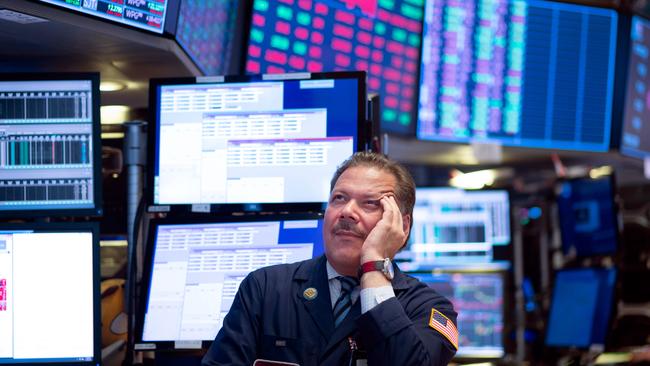
And Australia is at the front line in some of those events.
In cataloguing those bearish events, I am going to start with an Australian event that is not on anyone’s radar.
In recent days I have been talking to lower-ranking executives and employees in the banking, energy, and advertising industries.
Those people I’ve spoken to that have big mortgages are scared — really scared. And those that don’t have mortgages are becoming more and more reluctant to embrace one, despite low interest rates. In simple terms they are frightened they will lose their jobs.
Bank profits are being squeezed by the tougher regulations and lower interest rates plus the advent of new technology. They are retrenching staff. In the retail energy sector, severe clamps have been put on prices and a number of the big energy retailers have told their staff to prepare for widespread cuts. Advertising agencies and some media outlets are preparing for a similar exercise. You can also add some building companies and retailers to the list.
This week’s turbulence and the big fall on Wall Street will set these employment reduction plans in concrete.
The second event I’d like to focus on again received no attention. It actually happened in Denmark.
Denmark’s Jyske Bank is now offering a 10-year fixed rate mortgages at negative 0.5 per cent. Additionally, Finland-based Nordea Bank, operating in Denmark, will offer a 20-year fixed-rate mortgage that charges no interest.
Just think of it: a home loan with no interest for 20 years or negative interest for ten years. Remember, negative yield bonds dominate Europe’s capital markets. This its nuts and we all know that it is going to end badly.
And my third bad event (this time it is very much on the radar) is also likely to end badly. I devoted my comments on Wednesday to the Hong Kong threat to the region and what could happen in Australia.
More protests are planned and the drop on Wall Street might provide the cover for China to act.
China also needs a diversion from its faltering economy, which is my fourth danger event. China’s factory output has fallen to its lowest level in 17 years, while investment and retail sales have slowed. China’s billion-strong army of consumers is showing signs of becoming more frugal. And the bad China figures keep coming. Industrial output increased 4.8 per cent year-on-year in July, down from 6.3 per cent in June and marking the weakest pace since 2002. It was also well below the 6 per cent forecast by economists in a Bloomberg survey.
Clearly the world’s second-largest economy is being battered by an escalating trade war with the United States and slowing global demand.
No.5 is that Europe’s largest economy, Germany, is on the verge of falling into a recession. Eurozone GDP grew by just 0.2 per cent quarter on quarter; a significant slowdown from the 0.4 per cent growth in the first quarter.
Meanwhile, Brexit will not just hit the UK, and that makes it risk No.6. Europe’s potential will be reduced and if Boris Johnston does a trade deal with the US, making the UK part of a common market with the largest world economy. The UK may then avoid the worst of the European slump.
No.7: Our traditional long-term indicator, Dr Copper, was close to $US3 a pound six months ago. Now it’s below $US2.60. The iron ore fall has been even more dramatic. The Australian dollar is naturally falling, although gold has done very well. Into that mix we add the turmoil in the Middle East.
Finally, we get to the US and President Trump is blaming the Federal Reserve for being too slow to reduce official American interest rates. He believes that’s creating the US “negative yield curve” where short term rates are above the long-term bond rate.
..Spread is way too much as other countries say THANK YOU to clueless Jay Powell and the Federal Reserve. Germany, and many others, are playing the game! CRAZY INVERTED YIELD CURVE! We should easily be reaping big Rewards & Gains, but the Fed is holding us back. We will Win!
— Donald J. Trump (@realDonaldTrump) August 14, 2019
Actually, given the nasties around the world, the US is travelling fairly well and that has made the US Federal Reserve reluctant to reduce interest rates. US unemployment is historically low, consumer spending is booming, and the financial system is healthy. President Trump says he is winning the trade war but needs to Federal Reserve to lock in that victory. His problem is that he triggered many of the above events and they are spiralling into the US bond and now share markets.
It’s important to understand how bond and share traders see a negative yield curve.
Normally, long-term bonds pay out more than short-term bonds because investors demand to be paid more to tie up their money for a long time. When the key “yield curve” inverted, it signalled that investors are nervous about the near-term prospects for the US economy. Bonds and yields trade in opposite directions, so yields sink when investors buy bonds.
Actually part of the yield curve has been inverted for several months because in March, the yield on the 3-month Treasury bills rose above the rate on the 10-year Treasury note for the first time since 2007. But this week marked the first time in over a decade that the “main” yield curve — the 2-year to 10-year ratio — had inverted.
An inversion of the 2-10 curve has preceded every recession in modern history. However the 2007 great recession started nearly two years after the December 2005 yield-curve inversion.
Be ready for more market turbulence.




Global markets have been spooked by the so called “negative yield curve”. But the bigger, longer-term forces behind the big US share drop are that there are just too many nasty global events taking place at once.